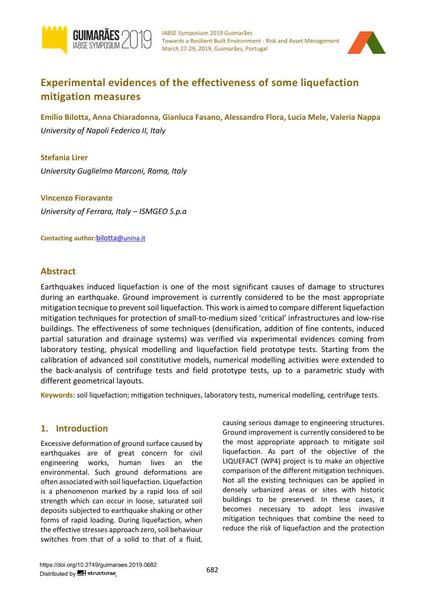Experimental evidences of the effectiveness of some liquefaction mitigation measures

|
|
|||||||||||
Bibliographic Details
| Author(s): |
Emilio Bilotta
(University of Napoli Federico II, Italy)
Anna Chiaradonna (University of Napoli Federico II, Italy) Gianluca Fasano (University of Napoli Federico II, Italy) Alessandro Flora (University of Napoli Federico II, Italy) Lucia Mele (University of Napoli Federico II, Italy) Valeria Nappa (University of Napoli Federico II, Italy) Stefania Lirer (University Guglielmo Marconi, Roma, Italy) Vincenzo Fioravante (University of Ferrara, Italy – ISMGEO S.p.a) |
||||
|---|---|---|---|---|---|
| Medium: | conference paper | ||||
| Language(s): | English | ||||
| Conference: | IABSE Symposium: Towards a Resilient Built Environment Risk and Asset Management, Guimarães, Portugal, 27-29 March 2019 | ||||
| Published in: | IABSE Symposium Guimarães 2019 | ||||
|
|||||
| Page(s): | 682-689 | ||||
| Total no. of pages: | 8 | ||||
| DOI: | 10.2749/guimaraes.2019.0682 | ||||
| Abstract: |
Earthquakes induced liquefaction is one of the most significant causes of damage to structures during an earthquake. Ground improvement is currently considered to be the most appropriate mitigation tecnique to prevent soil liquefaction. This work is aimed to compare different liquefaction mitigation techniques for protection of small-to-medium sized ‘critical’ infrastructures and low-rise buildings. The effectiveness of some techniques (densification, addition of fine contents, induced partial saturation and drainage systems) was verified via experimental evidences coming from laboratory testing, physical modelling and liquefaction field prototype tests. Starting from the calibration of advanced soil constitutive models, numerical modelling activities were extended to the back-analysis of centrifuge tests and field prototype tests, up to a parametric study with different geometrical layouts. |
||||
| Keywords: |
laboratory tests numerical modeling soil liquefaction mitigation techniques centrifuge tests
|
||||
